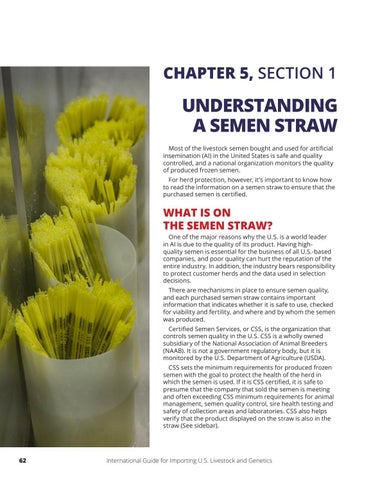CHAPTER 5, SECTION 1
UNDERSTANDING A SEMEN STRAW Most of the livestock semen bought and used for artificial insemination (AI) in the United States is safe and quality controlled, and a national organization monitors the quality of produced frozen semen. For herd protection, however, it’s important to know how to read the information on a semen straw to ensure that the purchased semen is certified.
WHAT IS ON THE SEMEN STRAW? One of the major reasons why the U.S. is a world leader in AI is due to the quality of its product. Having highquality semen is essential for the business of all U.S.-based companies, and poor quality can hurt the reputation of the entire industry. In addition, the industry bears responsibility to protect customer herds and the data used in selection decisions. There are mechanisms in place to ensure semen quality, and each purchased semen straw contains important information that indicates whether it is safe to use, checked for viability and fertility, and where and by whom the semen was produced. Certified Semen Services, or CSS, is the organization that controls semen quality in the U.S. CSS is a wholly owned subsidiary of the National Association of Animal Breeders (NAAB). It is not a government regulatory body, but it is monitored by the U.S. Department of Agriculture (USDA). CSS sets the minimum requirements for produced frozen semen with the goal to protect the health of the herd in which the semen is used. If it is CSS certified, it is safe to presume that the company that sold the semen is meeting and often exceeding CSS minimum requirements for animal management, semen quality control, sire health testing and safety of collection areas and laboratories. CSS also helps verify that the product displayed on the straw is also in the straw (See sidebar).
62
International Guide for Importing U.S. Livestock and Genetics











